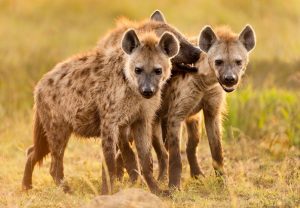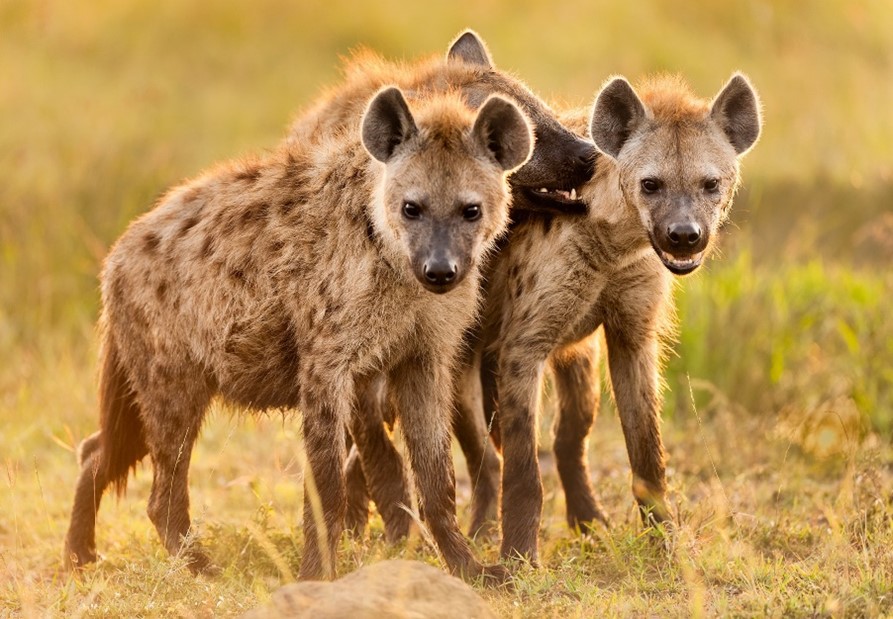HYENA
HYENA
Hyenas: Nature’s Clever Scavengers and Predators
Hyenas: Furry scavengers with powerful jaws, night prowlers, and keen senses, ruling the wilds of Asia and Africa.
Hyenas: These intelligent and curious creatures often intersect with human domains, occasionally earning disdain for raiding food stores, stealing livestock, and more. Surprisingly, they’re also sought after for traditional remedies. Sadly, misconceptions and persecution endanger their populations, underscoring the importance of protected areas.

Survival Strategies: The World of Spotted Hyenas
South of the Sahara, ginger-furred spotted hyenas display unique black spots. Females, larger than males, can grow up to 82 kg and 2 meters in length. They communicate through eerie sounds, with a 110-day gestation period yielding typically two cubs year-round. These versatile hunters pursue everything from young hippos to fish, often chasing wildebeest, gazelles, and zebras at 65 km/h for 3 miles. Spotted hyenas possess potent jaws and molars to devour their kills, digesting bones with strong stomach acid, allowing them to endure days between meals. Their capacious stomachs can hold up to 14.5 kg of meat.
Spotted Hyenas: Spotted hyenas, found in groups of 5 to 80, use scent marking to define territories. Females’ unique genitalia have social significance in greetings. A linear hierarchy places the lowest-ranking female above the highest male. Dominant females ensure better nutrition for cubs, while dominant males mate frequently. Cubs nurse for up to six months, even during lengthy maternal absences. Female cubs inherit status, and males may migrate to different clans.
Brown Hyenas: Weighing around 40 kg, brown hyenas feature dark coats, erect white manes, and horizontal leg stripes. In southern Africa and coastal deserts, they’re known as “beach wolves.” Their diet includes birds, eggs, insects, fruits, and seasonal scavenging from larger predators. Cubs, usually three, arrive after a 3-month gestation and are weaned by 15 months. Brown hyenas exhibit unique group dynamics, with females nurturing each other’s cubs, and food-sharing is common. Surprisingly, males aren’t subordinate to females.
give me some important question and answers for this topic”HYENA”.
- Q: What family do hyenas belong to in the animal kingdom?
A: Hyenas belong to the family Hyaenidae.
- Q: How many species of hyenas are there, and what are their names?
A: There are four species of hyenas: spotted hyena, brown hyena, striped hyena, and aardwolf.
- Q: Where are hyenas primarily found in the wild?
A: Hyenas are found in various habitats across Africa, the Middle East, and parts of Asia.
- Q: What is the most well-known species of hyena, and what distinguishes it from others?
A: The spotted hyena is the most well-known species. It is known for its distinctive spotted coat, powerful build, and strong jaws.
- Q: What is the role of hyenas in the ecosystem?
A: Hyenas play a crucial role in the ecosystem as scavengers and predators. They help control populations of herbivores and clean up carrion.
- Q: How do hyenas communicate with each other?
A: Hyenas communicate using vocalizations, including whoops, growls, and giggles. They also use body language and scent marking.
- Q: Are hyenas more closely related to dogs or cats?
A: Hyenas are more closely related to cats despite their appearance and behaviors that may resemble dogs.
- Q: What is the hyena’s reputation for scavenging and hunting?
A: Hyenas are skilled scavengers and are often associated with scavenging on carrion. However, they are also proficient hunters and can take down prey, particularly in groups.
- Q: How do hyenas use their powerful jaws?
A: Hyenas have strong jaws and sharp teeth. They use their jaws not only for eating but also for crushing bones, which allows them to access the nutritious marrow inside.
- Q: Do hyenas live in groups, and what is the social structure within a hyena clan?
A: Hyenas typically live in social groups called clans. The spotted hyena clan is led by a dominant female, and social hierarchy is matriarchal.
- Q: Can hyenas run at high speeds, and what is their primary mode of hunting?
A: Hyenas are capable of running at high speeds, especially during a chase. They are persistence hunters, meaning they exhaust and pursue their prey over long distances.
- Q: How do hyenas adapt to various environments, from savannas to deserts?
A: Hyenas are highly adaptable animals that can thrive in a range of environments. They are known for their intelligence and ability to find food in diverse landscapes.
- Q: What is unique about the reproductive anatomy of female spotted hyenas?
A: Female spotted hyenas have a pseudo-penis, which is an elongated clitoris. This unique anatomical feature is associated with the matriarchal social structure.
- Q: How do hyenas mark their territory?
A: Hyenas mark their territory using scent markings, including urine, feces, and anal gland secretions. These scent markings communicate information about the clan and its members.
- Q: Are hyenas endangered, and what are the main threats they face in the wild?
A: While hyenas are not generally considered endangered, they face threats such as habitat loss, human-wildlife conflict, and persecution due to misconceptions about their role in ecosystems.

